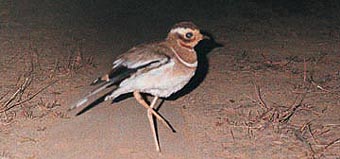|
Red
List Category & Criteria: CR C2a(ii) ver 3.1 (2001)
Year Assessed: 2004 Assessor/s: BirdLife International
Evaluator/s: Tobias, J., Crosby, M., Peet, N., Collar, N.
& Benstead, P.
(BirdLife International Red List Authority)
Justification: This recently rediscovered and poorly known
species qualifies as
Critically Endangered as a result of its single, small, declining
population, which is thought
to be threatened by exploitation of scrub-forest, livestock
grazing, disturbance and quarrying.
History: 1988 - Threatened (Collar and Andrew 1988)
1994 - Endangered (Collar, Crosby and Stattersfield 1994)
2000 - Critically Endangered (BirdLife International 2000)
IUCN
2007. 2007 IUCN Red List of Threatened Species. <www.iucnredlist.org>.
Downloaded on 10 April 2008.
|

Photo: ©Simon Cook
The Jerdon's Courser, Rhinoptilus bitorquatus, belongs to
the pratincole and courser family
Glareolidae. The bird was named after the zoologist Thomas
C. Jerdon who discovered it in 1848.
It was rediscovered in 1986 by Bharat Bhushan, an ornithologist
at the Bombay Natural History
Society after being thought to be extinct.

Photo: http://www.wii.gov.in
(not valid as per Sept. 2010)
This courser is a restricted-range endemic found locally in India
in the Eastern Ghats of
Andhra Pradesh. It is currently only known in the Sri Lankamalleshwara
Sanctuary,
inhabiting a sparse scrub forest interspersed with patches of bare
ground.
http://www.orientalbirdclub.org
It is an unmistakable
compact courser, with two brown breast-bands. It has a yellow bill
with a black tip, a blackish crown, broad buff supercilium, and
orange-chestnut throat patch. In flight it shows a mostly black
tail and a prominent white wingbar. It is a crepuscular bird and
is known to be vocal at dawn and dusk with in a series of staccato
Twick-too...Twick-too... Twick-too calls.
This bird was known only from a few historical records and was thought
to be extinct until its
rediscovery in 1986. It remains critically endangered due to loss
of habitat.
It is nocturnal in habit and presumed to be insectivorous.
Being a rare bird, nothing is known yet about its behaviour and
nesting habits.
Population estimates
for the bird vary from 25 to 200. Recent studies have made use of
techniques such as tracking strips where the footprints may be recorded.
Following the construction of the Somasilla dam, 57 villages were
relocated
into the region where the Courser was rediscovered. These areas
of Lankamalai, Palgonda and Seshachalam were previously not well
populated.
With the rising population here, there is also livestock pressure
and firewood extraction.
In addition extensive quarrying threatens the habitat.
In December 2005,
the only known location for the species was threatened by a canal
construction
project which threatened to destroy and alter the habitat of the
species.
(The Telagu-Ganga
canal that would have passed through one of these protected areas
was realigned
in response to lobbying that it would fragment habitat.)
The area has also been threatened by illegal construction work and
activities related to a project proposed to link the rivers of India.
Text:
http://en.wikipedia.org
Three additional sites for Jerdon's
courser have been discovered in recent years, all within 14 km
of the original rediscovery site. Unfortunately, one of these sites
has already been destroyed
by the recent canal construction.
Furthermore, because population survey work on this elusive species
is at an early stage,
other sites where the species has not yet been detected may well
be destroyed by further
construction work. These direct losses of habitat will undoubtedly
diminish an already
critically small population.
http://www.wildlifeextra.com









